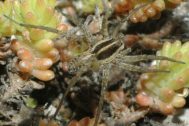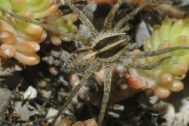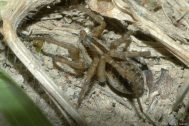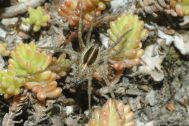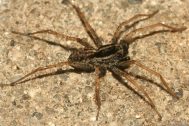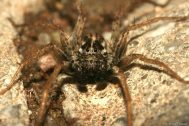| Nálezy podle období | |||||
|---|---|---|---|---|---|
| Lycosidae | 0-1900 | 1901-1950 | 1951-2000 | 2001+ | ∑ |
| Pardosa palustris (Linnaeus, 1758) Není ohrožený | 9× | 10× | 618× | 285× | 922× |
Pardosa palustris (Linnaeus, 1758)
| České jméno | slíďák luční |
|---|---|
| Stupeň ohrožení | Není ohrožený |
| Nálezy | 922 nálezů, 222 kvadrátů |
| První nález |
1860, F. Prach, Prach 1860 |
| Poslední nález | 2024 , Antonín Kůrka, Kryštof Rückl |
| Areál rozšíření | Holarctic, eM |
| Fytogeografická oblast |
|
| Původnost stanovišť |
|
| Vlhkost stanovišť |
|
| Stratum |
|
| Osvětlení stanovišť |
|
| Hojnost výskytu |
|
| Nadm. výška | 150-1550 |
Literatura
Food provisioning to Pardosa spiders decreases the levels of tissue-resident endosymbiotic bacteria
The diversity, host specificity, and physiological effects of endosymbiotic bacteria in spiders (Araneae) are poorly characterized. We used 16S rDNA sequencing to evaluate endosymbionts in the cephalothorax and legs of a wolf spider Pardosa agrestis. We tested the effects of feeding once or twice daily with fruit flies, aphids, or starved and compared them to those of syntopically occurring Pardosa palustris. The feeding increased traveled distance up to five times in some of the groups provisioned with food relative to the starved control. The Shannon diversity t-test revealed significant differences between these component communities of the two spider species. The increased frequency of feeding with fruit flies, but not aphids, increased the dominance and decreased the alpha diversity of OTUs. The obligate or facultative endosymbionts were present in all analyzed spider individuals and were represented mostly by Rickettsiella, Rhabdochlamydia, Spiroplasma, and the facultative intracellular parasite Legionella. Vertically transmitted endosymbionts were less common, represented by Wolbachia pipientis and Rickettsia sp. H820. The relative abundance of Mycoplasma spp. was negatively correlated with provisioned or killed aphids. In conclusion, the tissues of Pardosa spiders host tremendously diverse assemblages of bacteria, including obligate or facultative endosymbionts, with yet unknown phenotypic effects.
Linear peptides – a combinatorial innovation in the venom of some modern spiders
In the venom of spiders, linear peptides (LPs), also called cytolytical or antimicrobial peptides, represent a largely neglected group of mostly membrane active substances that contribute in some spider species considerably to the killing power of spider venom. By next-generation sequencing venom gland transcriptome analysis, we investigated 48 spider species from 23 spider families and detected LPs in 20 species, belonging to five spider families (Ctenidae, Lycosidae, Oxyopidae, Pisauridae, and Zodariidae). The structural diversity is extraordinary high in some species: the lynx spider Oxyopes heterophthalmus contains 62 and the lycosid Pardosa palustris 60 different LPs. In total, we identified 524 linear peptide structures and some of them are in lycosids identical on amino acid level. LPs are mainly encoded in complex precursor structures in which, after the signal peptide and propeptide, 13 or more LPs (Hogna radiata) are connected by linkers. Besides Cupiennius species, also in Oxyopidae, posttranslational modifications of some precursor structures result in the formation of two-chain peptides. It is obvious that complex precursor structures represent a very suitable and fast method to produce a high number and a high diversity of bioactive LPs as economically as possible. At least in Lycosidae, Oxyopidae, and in the genus Cupiennius, LPs reach very high Transcripts Per Kilobase Million values, indicating functional importance within the envenomation process.Fotografie
Statistiky
Dle měsíce v roce
Dle nadmořské výšky
Dle metody sběru (921 použitých nálezů)
| Pardosa palustris (Linnaeus, 1758) ES | Samci | Samice | Mláďata | Nálezy |
|---|---|---|---|---|
| Zemní past | 11186 | 3645 | 145 | 666 |
| Smyk | 9 | 10 | 1 | 18 |
| Individuální sběr | 210 | 72 | 5 | 100 |
| Žlutá miska | 126 | 29 | 0 | 39 |
| Prosev | 14 | 1 | 0 | 3 |
| Vysavač | 0 | 1 | 0 | 1 |
| Neurčeno | 32 | 28 | 0 | 91 |
| Sklepávání | 1 | 1 | 1 | 3 |
| Samci | Samice | Mláďata | Nálezy |
Dle biotopu (922 použitých nálezů)
| Pardosa palustris (Linnaeus, 1758) ES | Samci | Samice | Mláďata | Nálezy |
|---|---|---|---|---|
| Ruderály | 149 | 35 | 0 | 22 |
| Louky | 13 | 4 | 0 | 10 |
| Suché louky | 77 | 28 | 7 | 26 |
| Jeskyně | 0 | 1 | 0 | 1 |
| Kamenolomy | 15 | 6 | 1 | 10 |
| Skalní stepi na jiných horninách | 1 | 0 | 0 | 1 |
| Vřesoviště nižších poloh | 3 | 0 | 0 | 2 |
| Neurčeno | 4185 | 1720 | 5 | 325 |
| Lesy | 0 | 0 | 0 | 5 |
| Mezofilní louky | 2522 | 681 | 75 | 49 |
| Travnaté stepi | 1 | 0 | 0 | 1 |
| Mokřady | 0 | 0 | 0 | 3 |
| Paseky | 11 | 5 | 1 | 9 |
| Suché lesní lemy | 3 | 0 | 0 | 1 |
| Lužní lesy nížin | 22 | 3 | 0 | 6 |
| Lesní okraje | 21 | 16 | 0 | 17 |
| Suché křoviny | 6 | 4 | 1 | 6 |
| Mokré louky | 1422 | 163 | 25 | 66 |
| Kosodřevina | 0 | 0 | 0 | 1 |
| Úhory | 6 | 2 | 0 | 6 |
| Vrbové křoviny - vlhké (vrbové) křoviny | 6 | 1 | 0 | 2 |
| Těžebny písku a jiných nezpevněných hornin | 1 | 3 | 0 | 2 |
| Kukuřičná pole | 2 | 4 | 0 | 1 |
| Slaniska | 0 | 1 | 0 | 1 |
| Suché doubravy | 11 | 10 | 0 | 2 |
| Ostatní pole | 662 | 166 | 15 | 53 |
| Rašeliniště | 23 | 11 | 0 | 19 |
| Xerotermní travinobylinná společenstva | 107 | 54 | 0 | 16 |
| Lesy | 1 | 3 | 0 | 3 |
| Luční ostřicové mokřady | 2 | 0 | 0 | 1 |
| Louky a pastviny | 14 | 4 | 0 | 10 |
| Louky | 1269 | 531 | 6 | 62 |
| Stojaté a pomalu tekoucí vody | 1 | 1 | 0 | 2 |
| Horské biotopy | 5 | 3 | 0 | 3 |
| Vlhké lesní lemy | 2 | 1 | 0 | 2 |
| Močály | 12 | 2 | 0 | 7 |
| Skalní stepi na vápenci | 66 | 19 | 10 | 18 |
| Pastviny | 77 | 24 | 1 | 22 |
| Haldy a výsypky | 1 | 3 | 0 | 7 |
| Ovocné sady s luční vegetací | 437 | 189 | 0 | 29 |
| Bylinné porosty břehů | 37 | 18 | 0 | 4 |
| Písčiny | 0 | 2 | 2 | 3 |
| Ostřicové porosty stojatých vod | 5 | 1 | 2 | 3 |
| Kamenité suti nižších poloh | 1 | 3 | 0 | 3 |
| Břehy tekoucích vod | 32 | 10 | 0 | 13 |
| Výsadby jehličnanů | 8 | 1 | 1 | 7 |
| Acidofilní bory | 19 | 1 | 0 | 3 |
| Rákosiny a orobincové porosty stojatých vod | 6 | 5 | 0 | 5 |
| alpínské trávníky | 205 | 25 | 0 | 17 |
| Horské smrčiny | 0 | 0 | 0 | 1 |
| Dubohabřiny | 2 | 0 | 0 | 2 |
| Polní biotopy | 63 | 10 | 0 | 4 |
| Bučiny nižších poloh | 2 | 0 | 0 | 1 |
| Porosty borůvek | 3 | 0 | 0 | 3 |
| Okraje silnic | 1 | 1 | 0 | 2 |
| Zahradnicky utvářené zahrady a parky | 3 | 2 | 0 | 2 |
| Suťové a roklinové lesy | 0 | 1 | 0 | 1 |
| Lesostepní doubravy | 35 | 10 | 0 | 18 |
| Přirozené lesy | 1 | 0 | 0 | 1 |
| Samci | Samice | Mláďata | Nálezy |




